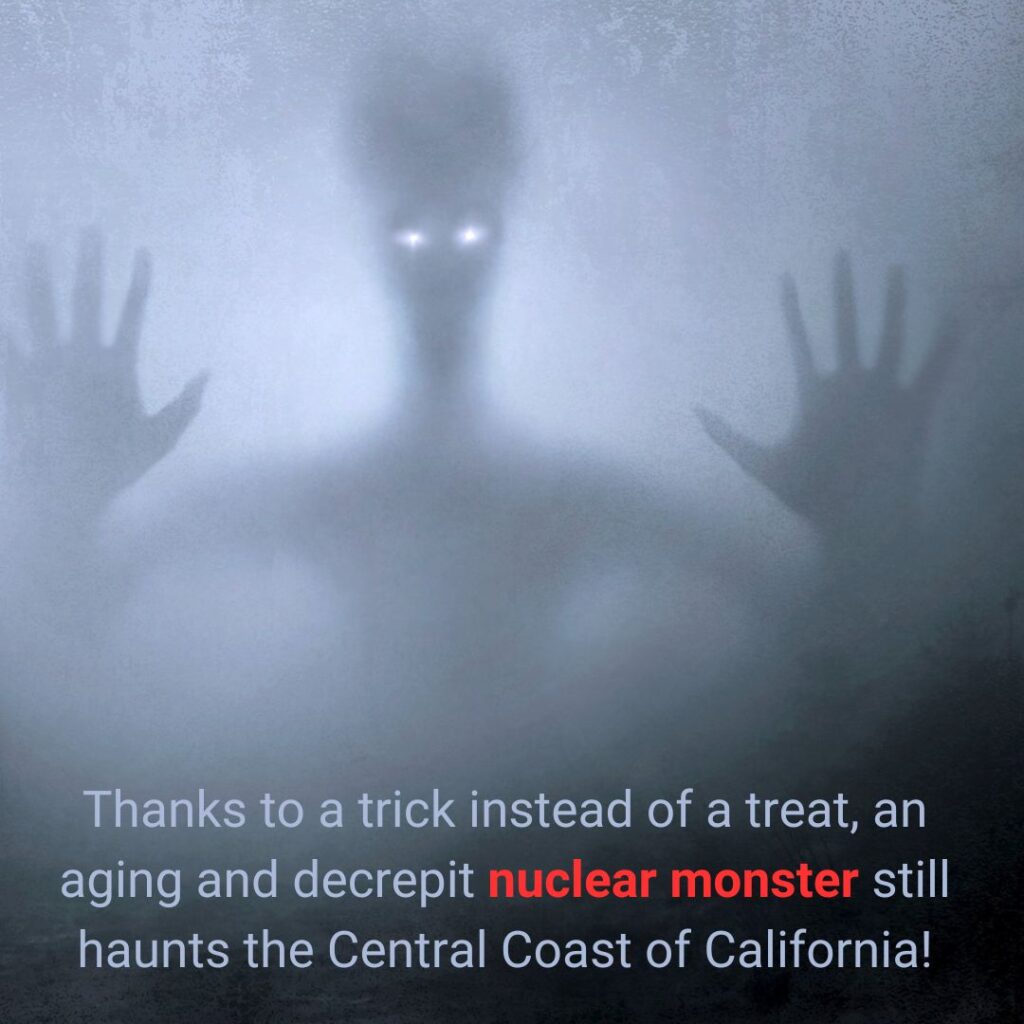
Halloween Fright: Thanks to a trick instead of a treat by Governor Newsom, an aging nuclear monster still haunts the Central Coast of California
November 2 was set to mark the closure of Diablo Canyon Nuclear Power Plant Unit 1, but SB 846 extended the aging reactor’s life through 2030. New data from the Governor’s office on renewable battery storage shows there’s no need for Diablo.
November 2 was meant to deliver a long-expected treat to Californians: the closure of Unit 1 nuclear reactor at Diablo Canyon Nuclear Power Plant on the expiration date of its 40-year license. But thanks to a surprise trick by Governor Gavin Newsom played on the California State Legislature in 2022, the reactor will continue operating indefinitely without critical seismic upgrades and safety tests. The reactor’s owner, Pacific Gas and Electric Co. (PG&E), has also failed to install cooling towers essential to meet Clean Water Act standards for protecting marine life.
Until September 2022, California residents could anticipate the timely closure of Diablo Canyon’s reactors. Under a hard-fought 2016 agreement between PG&E, labor unions, environmental groups, and others, Unit 1 was set to shut down on November 2, 2024, followed by Unit 2 in 2025. But in a last-minute move on September 1, 2022, pressured by the Governor, the State Legislature passed Senate Bill 846, extending Diablo Canyon’s operations to 2030. PG&E, meanwhile, went further, applying for a 20-year license extension—going four times beyond the five years specified in SB 846.
Despite the Governor’s warnings of power outages without Diablo Canyon, no such disruptions have occurred. Even during this past summer’s record-breaking heat waves, California’s energy grid met demand, demonstrating the success of renewable resources and battery storage. This stability shows that California can maintain a reliable grid without a hazardous nuclear plant.
In fact, since the Legislature’s 2022 vote, California has rapidly expanded its renewable capacity. By October 2024, data from the California Energy Commission and Public Utilities Commission showed an estimated capacity of 13,391 MW of battery storage—well above the 2,200 MW produced by Diablo Canyon’s reactors. Touting these gains, the Governor’s office stated on October 15 that this growth of California’s battery storage capacity “marks a 30% increase since April 2024, underscoring the state’s swift progress in building out clean energy infrastructure, especially during a summer marked by record-breaking heat.”
Linda Seeley, spokesperson for Mothers for Peace, remarked: “SB 846 prioritized an unfounded energy need over public health and environmental safety, disregarding both seismic risks and the growing embrittlement of Unit 1’s pressure vessel.” She added, “California has the tools to ensure reliable, clean energy through renewables and battery storage. We don’t need to compromise health and safety to keep the lights on.”
Diane Curran, attorney for the group, stated that both PG&E and the Nuclear Regulatory Commission (NRC) have failed to ensure the safety of the embrittled Unit 1 pressure vessel, a critical safety component that holds the reactor core. “The NRC is also allowing Unit 1 to operate past Nov. 2 despite serious concerns that earthquake faults under Diablo Canyon, which were discovered after it was built, could cause a nuclear accident,” Curran said.
She noted that the group’s concerns have been documented in testimony to state and federal regulators by Dr. Digby Macdonald, Professor Emeritus of nuclear materials science at the University of California and Dr. Peter Bird, Professor Emeritus of Geosciences at UCLA. For a detailed explanation by Dr. Bird of the seismic dangers facing Diablo Canyon, watch the video here.
November 2 should have been the Halloween treat Californians deserved, not the trick we received. When Halloween is over, this monster will continue to loom, threatening the health, safety, environment, and well-being of residents of the Golden State.
